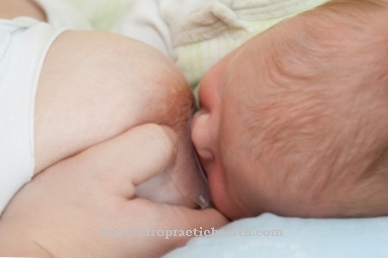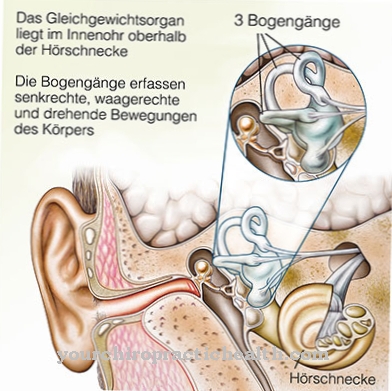In the Osteochondrosis it is a disease of the bones. There are different types of disease, in which, for example, the bones decompose or an unnaturally large layer of cartilage forms. Often wear and tear is the cause of the disease, which manifests itself in sometimes severe pain.
What is osteochondrosis?

© Corona Borealis - stock.adobe.com
The term Osteochondrosis describes a so-called degenerative bone disease. There are different types of this disease. The most common is osteochondrosis intervertebralis (wear and tear on the spine that leads to hardening of the bone tissue).
Basically, osteochondrosis manifests itself as joint or back pain, which becomes worse as the disease progresses. The disease can have various causes, including incorrect stress on the joints and insufficient movement. Advanced age and risk factors such as obesity favor the development of osteochondrosis.
Once a corresponding change in the bone tissue has occurred, it cannot be reversed. Therapy accordingly only includes the alleviation of symptoms, which can take place with drugs or surgery.
causes
The causes of a Osteochondrosis In many cases they are a natural symptom of wear and tear that occurs with increasing age. At a young age, stress (including excessive or incorrect stress) can be absorbed.
Later, however, the bones, cartilage and muscles increasingly weaken. As a result, small pieces of bone become detached and there is a change in the height of the intervertebral spaces (especially in the case of osteochondrosis intervertebralis). Ultimately, this leads to painful movements, which get worse over time. Often it is also permanent incorrect loads that can significantly increase the risk of osteochondrosis.
Under certain circumstances, rheumatic disease can also be the reason for osteochondrosis. In the less common form of osteochondrosis dissecans, the body cannot convert its own cartilage cells into bone material as intended, which leads to excessive cartilage in the joints.
Typical symptoms & signs
- Joint pain
- Back pain
- Bone pain
Diagnosis & course
A Osteochondrosis is usually only noticed by those affected when the pain has already developed significantly. If a doctor is visited as a result, an X-ray is taken in addition to a detailed discussion with the patient.
In many cases, this can provide clear information as to whether the vertebrae or joints are worn and, in the case of osteochondrosis intervertebralis, the typical height changes in the intervertebral spaces have formed. If the disease is at an early stage or if no clear statements can be made about changes, magnetic resonance imaging (MRI) can also be performed.
If osteochondrosis is left untreated, the pain increases and the associated restrictions on movement occur, which can significantly reduce the quality of life of the person affected.
Complications
The further complications and complaints of osteochondrosis depend very much on the cause and the severity of the disease. As a rule, however, those affected suffer from various complaints of the bones and cartilage. Due to the osteochondrosis, those affected primarily suffer from severe pain, which mainly occurs in the joints. This results in considerable restrictions in the everyday life and in the life of the patient, so that they depend on the help of other people.
Pain in the back or in the bones themselves can also become noticeable and significantly reduce the quality of life of the person affected. If the disease already occurs in children, there can be significant delays in the development of the child, so that these patients are dependent on walking aids or other people even in adulthood.
As a rule, osteochondrosis cannot be treated. Those affected are dependent on various therapies that can alleviate and limit the symptoms. With the help of heat treatments or massages, the quality of life can be increased again. As a rule, life expectancy itself is not reduced.
When should you go to the doctor?
If bone thickening and other signs of osteochondrosis are noticed, a doctor should be consulted immediately. The disease can be treated relatively well if diagnosed at an early stage, but in any case requires close monitoring by the doctor. Therefore, the doctor should be consulted at the first signs of illness. At the latest when movement restrictions or pain occur as a result of osteochondrosis, a doctor's visit is indicated. People who have suffered from bone diseases or have a malformation in the past are particularly at risk.
People with congenital bone malformations should also see a doctor if the symptoms mentioned occur. Osteochondrosis is treated by an orthopedic surgeon. Other contact persons can be specialists in internal medicine as well as physiotherapists, sports medicine specialists and specialists in bone diseases. Surgical treatment is necessary for severe symptoms. The patient has to go to the hospital for a few days and then have regular check-ups to rule out serious complaints and complications or to be able to identify and treat them at an early stage.
Treatment & Therapy
Became a Osteochondrosis diagnosed, the attending physician will initiate appropriate therapy. Once there has been damage to the bone tissue in the spine or the joints, this cannot be completely reversed.
Early detection of the disease is all the more important in the case of osteochondrosis. In most cases, the symptoms, i.e. the pain, are first relieved as part of a medical treatment, for which appropriate medication is administered. In addition to painkillers, muscle relaxants can also be used. Massages, heat or stimulation current applications also help to reduce the symptoms, as do certain physiotherapy exercises.
Surgical intervention may be required for advanced osteochondrosis. In this way, hardened cartilage tissue can be removed or, if necessary, an intervertebral disc or joint prosthesis can be inserted. As a result, incorrect and excessive loads should be avoided in any case.
You can find your medication here
➔ Medicines for joint painOutlook & forecast
What prognosis is possible in the presence of osteochondrosis is defined by the time of diagnosis. With early diagnosis, the chances of resolving the sequelae are better. As a rule, treatment becomes significantly more complex with a later diagnosis. The chances of healing are clearly worsened.
The reason for this lies in the nature of the disease. Osteochondrosis causes the spine to curve. Cartilaginous joint parts change. If the osteochondrosis is left untreated for a long time, the prognosis is not positive. Only if the disease is recognized at an early stage and treated immediately does it have very good to good prospects of a cure. As valuable time passes, the therapy options change. The chances of recovery worsen.
The problem with osteochondrosis is that already established tissue irritations or ossification do not regress. The longer the disease progresses, the less doctors can do for those affected. The second limiting factor is where the osteochondrosis manifested itself. Experience has shown that osteochondrosis in the lumbar spine is more likely to heal than bone degeneration that has formed in the cervical spine.
After the diagnosis, those affected must avoid anything that aggravates the consequences of the disease. If the osteochondrosis is already advanced, the spine often has to be stiffened. Mobility is severely restricted postoperatively.
prevention
One Osteochondrosis can be prevented to a certain extent by eating a balanced diet rich in vitamins D, for example. Sufficient exercise strengthens the muscles and also prevents wear and tear. However, excessive or improper stress on the back and / or joints should be avoided. Participation in a back school, for example, can help to maintain the correct posture over the long term and thus prevent painful complaints from developing.
Aftercare
In most cases, the measures and the options for direct follow-up care for osteochondrosis prove to be relatively difficult, so that the person affected should ideally contact a doctor very early on. The earlier a doctor is consulted, the better the further course of the disease is usually. Self-healing cannot occur.
The further course depends very much on the time of diagnosis and also on the severity of the disease. Most patients are dependent on physical therapy and physiotherapy measures in order to relieve the symptoms permanently and correctly. Many of the exercises from such therapies can be repeated in your own home.
The support and care of your own family and relatives is also very important, as this can also prevent depression and other psychological upsets. A healthy lifestyle with a healthy diet and light sporting activities also have a positive effect on the further course of the disease. Failures or overloading of the affected regions must be avoided in any case. As a rule, osteochondrosis does not reduce the life expectancy of the person affected.
You can do that yourself
Osteochondrosis patients are often restricted in their mobility. The main goal of therapy is pain relief, for which analgesics and natural pain relievers such as peppermint oil or cloves are used. Regular use of the prescribed and self-selected preparations is essential to calm the muscles and relieve chronic pain.
Complete bed rest is recommended for severe illnesses. Physiotherapy can also be effective for osteochondrosis. In combination or as an alternative, patients can also undergo heat or electrotherapy. Through moderate exercise and the activation of the joints, a targeted attempt is made to maintain the freedom of movement of the affected body regions. In addition, exercise strengthens the surrounding muscle groups, which have to compensate for the restrictions.
A visit to the back school is recommended for training your back. There, the sick learn to cultivate a better posture and analyze situations in which improper stress can occur. Back training is an important part of therapy and can either be done with a physiotherapist or independently at home. Which self-help measures make sense in detail should be discussed with the responsible doctor.

.jpg)
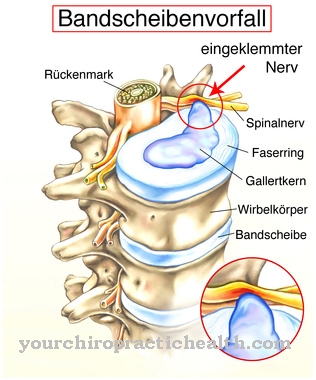
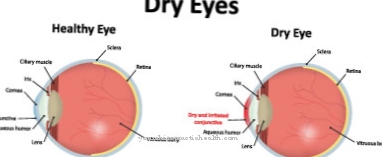
.jpg)

.jpg)

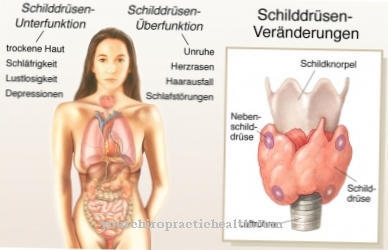




.jpg)

.jpg)



